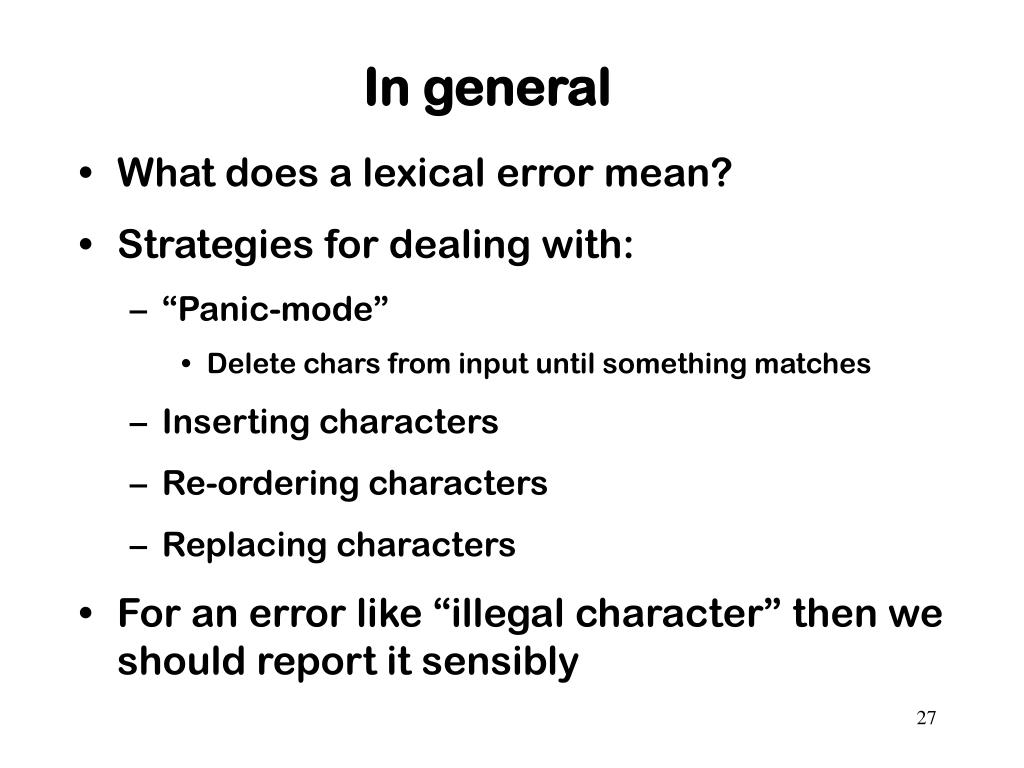

- #Context free grammar panic mode software#
- #Context free grammar panic mode code#
- #Context free grammar panic mode series#
Cross-compilerĪ compiler that runs on platform (A) and is capable of generating executable code for platform (B) is called a cross-compiler. It initializes various registers to initiate execution. It calculates the size of a program (instructions and data) and creates memory space for it. Loader is a part of operating system and is responsible for loading executable files into memory and execute them. The major task of a linker is to search and locate referenced module/routines in a program and to determine the memory location where these codes will be loaded, making the program instruction to have absolute references. All these files might have been compiled by separate assemblers.

Linker is a computer program that links and merges various object files together in order to make an executable file. AssemblerĪn assembler translates assembly language programs into machine code.The output of an assembler is called an object file, which contains a combination of machine instructions as well as the data required to place these instructions in memory. whereas a compiler reads the whole program even if it encounters several errors. If an error occurs, an interpreter stops execution and reports it. In contrast, an interpreter reads a statement from the input, converts it to an intermediate code, executes it, then takes the next statement in sequence. A compiler reads the whole source code at once, creates tokens, checks semantics, generates intermediate code, executes the whole program and may involve many passes. The difference lies in the way they read the source code or input. InterpreterĪn interpreter, like a compiler, translates high-level language into low-level machine language. It deals with macro-processing, augmentation, file inclusion, language extension, etc. PreprocessorĪ preprocessor, generally considered as a part of compiler, is a tool that produces input for compilers. The C compiler, compiles the program and translates it to assembly program (low-level language).Īn assembler then translates the assembly program into machine code (object).Ī linker tool is used to link all the parts of the program together for execution (executable machine code).Ī loader loads all of them into memory and then the program is executed.īefore diving straight into the concepts of compilers, we should understand a few other tools that work closely with compilers. User writes a program in C language (high-level language). Let us first understand how a program, using C compiler, is executed on a host machine. Similarly, an assembler is a program that converts the assembly language to machine-level language. A compiler is a program that converts high-level language to assembly language. The high-level language is converted into binary language in various phases.

This is known as Language Processing System.
#Context free grammar panic mode series#
These programs are then fed into a series of tools and OS components to get the desired code that can be used by the machine. So we write programs in high-level language, which is easier for us to understand and remember. The hardware understands a language, which humans cannot understand. We have learnt that any computer system is made of hardware and software. It would be a difficult and cumbersome task for computer programmers to write such codes, which is why we have compilers to write such codes.

To instruct, the hardware codes must be written in binary format, which is simply a series of 1s and 0s. Binary language has only two alphabets, 0 and 1.
#Context free grammar panic mode software#
Hardware understands instructions in the form of electronic charge, which is the counterpart of binary language in software programming. Hardware is just a piece of mechanical device and its functions are being controlled by a compatible software. Computers are a balanced mix of software and hardware.


 0 kommentar(er)
0 kommentar(er)
